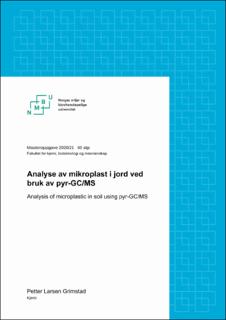| dc.contributor.advisor | Kallenborn, Roland Peter | |
| dc.contributor.author | Grimstad, Petter Larsen | |
| dc.date.accessioned | 2022-01-24T14:56:18Z | |
| dc.date.available | 2022-01-24T14:56:18Z | |
| dc.date.issued | 2021 | |
| dc.identifier.uri | https://hdl.handle.net/11250/2839030 | |
| dc.description.abstract | I 2018 ble det produsert 359 million ton plastikk. Siden plast er sjeldent biologisk nedbrytbart når det kommer ut i naturen, vil den gå igjennom en rekke biologiske, kjemiske og fysiske prosesser. Dette resulterer i at den blir fragmentert til mindre partikler, altså mikroplast. Mikroplast har blitt funnet i en rekke marinemiljøer, jordmiljøer, og i en rekke dyr som befinner seg i marine eller jordiske miljø. Dette betyr at mikroplast kan bli ført videre opp i matkjeden til maten som mennesker spiser. Det er derfor viktig å ha analysemetoder som kan pålitelig kvantifisere plast i en prøve. Pyrolyse-GC/MS er en av de mest lovende analyseteknikkene innenfor polymer karakterisering og er et raskt voksende fagområde, som vist ved det økende antall publikasjoner. Dermed er hovedmål med oppgaven å etablere en kvalitativ og kvantitativ analysemetode for bestemmelse av spesifikke polymerer ved bruk av pyr-GC/MS og pyr-ATD-GC/MS. Oppgaven består av 4 deler; identifikasjon av polymerer, utvikling av MRM-metode, metodevalidering og analyse av jordprøver.
Det ble laget en analysemetode for å identifisere pyrolyse produktene til polymerene PE, PP, PVC og PTFE. Analysemetoden ble brukt på pyrolyse ovnene Pyrola og Carbolite. Resultatene viser at analysemetoden kan identifisere de utvalgte polymerene. PVC og PTFE ga pyrolyse produkter som ikke finnes naturlig.
PVC og PTFE ble valgt for MRM-metode. Product ion scan ioner utvalgt for PVC og PTFE var 112 og 100 m/z. Disse ble analysert med Product ion scan metode på Pyrola og Carbolite, med kollisjonsenergier på 5, 15, 20 og 30. MRM-overganger som ga best resultat for PVC er 112→77 m/z med kollisjonsenergi på 15 og PTFE ga 100→ 69 m/z med kollisjonsenergi på 5.
For metodevalidering ble PVC løst i THF brukt. LOD ble funnet til å ligge på 4,36 ng/μL, LOQ ble funnet til å ligge på 14,53 ng/μL og MDL ligger på 3,36 ng/μL. Repeterbarhet ble funnet til å ha en spredning under 5% utenom 5 ng/μL som hadde en spredning på 29%. Lineariteten ble funnet til å være 0,9995.
Til slutt ble 3 jordprøver med 5Wt%, 1Wt% og 0,1Wt% med PVC og PTFE analysert med MRM metode på Pyrola ovn. Metoden klarte å analysere og detektere PVC og PTFE i jord, selv ved små mengder. | en_US |
| dc.description.abstract | In 2018, 359 million tonnes of plastic were produced. Since plastic is rarely biodegradable when released into nature, it will undergo several biological, chemical, and physical processes. This results in it being fragmented into smaller particles, i.e., microplastics. Microplastics have been found in several marine environments, terrestrial environments, and in several animals that are in marine or terrestrial environments. This means that microplastics can be carried further up the food chain to the food that people eat. It is therefore important to have an analysis method that can reliably quantify plastic in a sample. Pyrolysis GC / MS is one of the most promising analytical techniques in polymer characterization and is a rapidly growing field, as shown by the increasing number of publications. Thus, the main goal of the project is to establish a qualitative and quantitative analysis method for the determination of specific polymers using pyr-GC / MS and pyr-ATD-GC / MS.
The thesis consists of 4 parts: identification of polymers, development of MRM method, method validation and analysis of soil samples.
An analysis method was made to identify the pyrolysis products of the polymers PE, PP, PVC, and PTFE. The analysis method was used on Pyrola and Carbolite furnace. The results show that the analysis method can identify the selected polymers. PVC and PTFE gave pyrolysis products that do not exist in nature.
PVC and PTFE were chosen for MRM method. Product scan ions selected for PVC and PTFE were 112 and 100 m / z. These were analyzed with product scan method on Pyrola and Carbolite, with collision energies of 5, 15, 20 and 30. MRM transitions that gave the best result for PVC are 112→77 m/z with collision energy of 15 and PTFE gave 100→ 69 m/z with collision energy of 5.
For method validation, PVC dissolved in THF was used. LOD was found to be 4.36 ng/µL, LOQ was found to be 14.53 ng/µL and MDL is 3.36 ng/µL. Repeatability was found to have a spread below 5% except for 5 ng/µL which had a spread of 29%. The linearity was found to be 0.9995.
Finally, 3 soil samples with 5Wt%, 1Wt% and 0.1Wt% with PVC and PTFE were analyzed by MRM method on Pyrola furnace. The method was able to analyze and detect PVC and PTFE in soil, even in small amounts. | en_US |
| dc.language.iso | nob | en_US |
| dc.publisher | Norwegian University of Life Sciences, Ås | en_US |
| dc.rights | Attribution-NonCommercial-NoDerivatives 4.0 Internasjonal | * |
| dc.rights.uri | http://creativecommons.org/licenses/by-nc-nd/4.0/deed.no | * |
| dc.title | Analyse av mikroplast i jord ved bruk av pyr-GC/MS | en_US |
| dc.title.alternative | Analysis of microplastic in soil using pyr-GC/MS | en_US |
| dc.type | Master thesis | en_US |
| dc.description.localcode | M-KJEMI | en_US |

